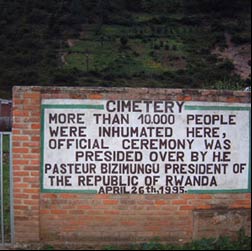
| This memorial, for the 10,000 massacred at Kibuye stadium, sits at the side of the stadium field. Inside the gates sits a mass grave, unmarked and untended. Photo: Internews |
|
Butare Kigali Kibuye Bisesero
Extermination Centers April 17-18, 1994 During the violence that erupted in the first weeks of April 1994, thousands of people were displaced from their homes. Government officials directed many to take refuge in places such as schools, churches and stadiums. In previous attacks, these types of locations had been safe shelters. But during the 1994 genocide, they became extermination centers. Kibuye, a town in the northwest corner of the country, was the site of two such massacres that resulted in the murder of thousands of people over four days. The first massacre occurred at the St. Jean Catholic Church and Home Complex which sits on a piece of land surrounded on three sides by Lake Kivu. By April 17, thousands of unarmed men, women and children, predominantly Tutsi, had taken refuge there. Using guns, grenades, machetes, spears, cudgels and other weapons, members of the Gendarmerie Nationale; police from the Commune of Gitesi (where Kibuye town sits); Interahamwe fighters and armed civilians attacked and killed those who had gathered. The second massacre happened at the Gatwaro Stadium located on the main road in Kibuye town. As with the people who gathered at the St. Jean Church and Home Complex, those who congregated at the stadium were told to go there by government officials. Once there, they were not allowed to leave. Without food or water, the captives ate grass. On April 18, Gendarmerie Nationale soldiers; Gitesi Police; Interhamwe fighters and armed civilians surrounded the stadium. A gunshot in the air initiated the massacre. Thousands were killed that day. The next morning, the attackers returned and killed any who had survived. Sources: Judicial Diplomacy Web report Human Rights Watch report, "Leave None to Tell the Story." March 1999; ICTR reports and testimony. |
| Close Window |